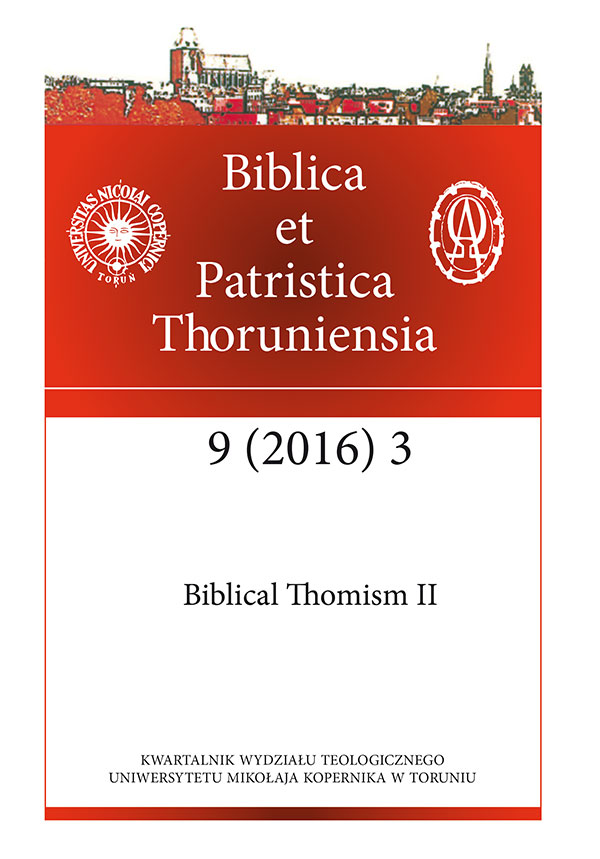La controversia giuridica (rîb) di 2 Sam 11,27b-12,15a
DOI:
https://doi.org/10.12775/BPTh.2016.027Słowa kluczowe
kontrowersja prawna, rîb, spór, oskarżenie, samooskarżenie, oskarżyciel, oskarżony, sędzia, sąd, winny, wina, grzech, spowiedź-wyznanie, przebaczenie, sprawiedliwość, przypowieść, Bóg, król Dawid, prorok NatanAbstrakt
Kontrowersja prawna (rîb) w 2 Sm 11,27b-12,15a
Studium 2 Sm 11,27b-12,15a, którego próba została podjęta w niniejszym artykule, przedstawia ciekawy przykład rîb, który jest sporem (kontrowersją) zaistniałym między dwoma stronami prawnymi i składającym się z trzech faz (lub trzech elementów): oskarżenia, zeznania oskarżonego oraz pojednania (por. Tabela I). W pierwszej fazie oskarżeniowej tej kontrowersji znajduje się potrójne oskarżenie razem ze swoją gradacją (stopniowaniem) ze strony Boga, Natana i Dawida. Część oskarżycielska znajdująca się w wersetach 2 Sm 11,27b-12,12 jest bardzo bogata i interesująca pod względem rîb oraz procesu prawnego (por. Tabela II). Ten potrójny proces oskarżycielski w 2 Sm (A=11,27b; B=12,1b-4; C=12,5b) ze swoim stopniowaniem (ze strony Boga, proroka i króla) oraz ze swoim powtórzeniem (A1=12,7b-12; B1=12,7a; C1=12,6a) prowadzi do wyznania (przyznania się) Dawida (12,13a), to znaczy do zeznania oskarżonego, które jest drugą częścią (fazą) kontrowersji prawnej. Natomiast wiersze 13b-14 są trzecim i ostatnim etapem (fazą) rîb w 2 Sm 12, który wyraża pojednanie między Bogiem i Dawidem. Bóg (oskarżyciel) poprzez Natana (oskarżyciela) udziela przebaczenia Dawidowi (oskarżonemu i samooskarżycielowi).
Z analizy 2 Sm 11,27b-12,15a wynika, że Bóg w rîb nie objawia się (nie ukazuje się) jako surowy sędzia między dwoma stronami w konflikcie, ale jako oskarżyciel (oskarżający), który nie chce zwyciężyć czy też pokonać upokarzając oskarżonego, lecz przekonać go do poprawy i do zmiany jego postępowania. Bóg zachowuje się jako jedna ze stron przymierza, jako jego uczestnik, który pragnie raczej zbawić i uratować niż potępić czy skazać swojego winnego sprzymierzeńca (sojusznika). Przed oskarżycielem-miłosiernym oskarżony-niesprawiedliwy otwiera się i uznaje się za winnego, przyznaje się do własnego grzechu (winy, wykroczenia) i otrzymuje na koniec od niego przebaczenie. Proces rîb kończy się pojednaniem dwóch stron, oskarżyciela i oskarżonego.
Rozpoznać i wyznać własny grzech, jak to uczynił Dawid (2 Sm 12,13a), jest wielkim aktem uwielbienia Pana dlatego, że przyznanie się do grzechów i ich wyznanie staje się równocześnie wyznaniem wiary w Boga. Ten kto się spowiada składa najpiękniejszą ofiarę Bogu, a jednocześnie manifestuje najlepszy gest (postawę) przed Panem bowiem wielkość człowieka wyraża się właśnie wtedy kiedy wypowiada on prawdę o samym sobie. Serce skruszone, otwarte, szczere, pokorne podczas spowiedzi nie tylko prosi o przebaczenie Boga, ale także pozwala samemu Bogu wybawić i uwolnić grzesznika od konsekwencji grzechu oraz od jego nieszczęśliwych następstw. Oto prawdziwe oblicze Bożego miłosierdzia, które opiera się na sprawiedliwości ludzkiej zgodnej ze sprawiedliwością Bożą, a które ukazuje się w kontrowersji prawnej czyli w rîb.
Bibliografia
Anderson A. A., 2 Samue l(WBC 11), Dallas 1989.
Auld A. G., I & II Samuel, Louisville 2011.
Auld A. G., Eynikel E., For and against David: Story and History in the Books of Samuel, Leuven 2010.
Bodi D., The demise of the warlord: a new look at the David story, Sheffield 2010.
Bovati P., I rîb profetici, Roma 1997.
Bovati P., Ristabilire la giustizia. Procedure, vocabolario, orientamento, Roma 2005.
Costacurta B., Lo scettro e la spada. Davide diventa re (2 Sam 2-12), Bologna 2006.
Firth D., 1 and 2 Samuel: A Kingdom Comes, Sheffield 2013.
Gioda S., Dizionario, sinonimi e contrari, Roma 1992.
Gordon R.P., 1 & 2 Samuel, Sheffield 1984.
Haag H., Dizionario biblico, Torino 1960.
Janzen D., The condemnation of David’s “taking” in 2 Samuel 12:1-14, JBL (2012), pp. 209-220.
Jones G. H., The Nathan narratives (JSOT.SS 80), Sheffield 1990.
Joüon P.P., Grammaire de l’hébreu biblique, Roma 1987 (ristampa).
Koenig S. M., Isn’t this Bathsheba? A study in characterization, Eugene 2011.
Lambdin T. O., Introduction to biblical Hebrew, London 1990.
McCarter P. K., II Samuel (AB 9), New York 1984.
McKenzie J. L., Dizionario biblico, Assisi 1978.
Oswald W., Nathan der Prophet: Eine Untersuchung zu 2 Samuel 7 und 12 und 1 Könige 1, Zürich 20.
Ravasi G., Il Libro dei Salmi, vol. I, Bologna 1981.
Ravasi G., Il Libro dei Salmi, vol. II, Bologna 1988.
Ravasi G., Samuele, in: Nuovo Dizionario di Teologia Biblica, Torino 1988, 1418.
Schipper J., Did David overinterpret Nathan’s parable in 2 Samuel 12:1-6?, JBL 126.2 (2007), pp. 383-407.
Schökel A., Trenta Salmi, Bologna 1982.
Sicre J.L., I profeti d’Israele e il loro messaggio, Roma 1989.
Simon H., The poor man’s ewe-lamb. An example of a juridical parable, Bib 48 (1967), pp. 207-242.
Vella J., La giustizia forense di Dio, Brescia 1964.
Vogels W., David et son histoire. 1 Samuel 16,1 – 1 Rois 2,11, Montréal 2003.
Pobrania
Opublikowane
Jak cytować
Numer
Dział
Licencja
CC BY ND 4.0. Posiadaczem prawa autorskiego (Licencjodawcą) jest Autor, który na mocy umowy licencyjnej udziela nieodpłatnie prawa do eksploatacji dzieła na polach wskazanych w umowie.
- Licencjodawca udziela Licencjobiorcy licencji niewyłącznej na korzystanie z Utworu/przedmiotu prawa pokrewnego w następujących polach eksploatacji: a) utrwalanie Utworu/przedmiotu prawa pokrewnego; b) reprodukowanie (zwielokrotnienie) Utworu/przedmiotu prawa pokrewnego drukiem i techniką cyfrową (e-book, audiobook); c) wprowadzania do obrotu egzemplarzy zwielokrotnionego Utworu/przedmiotu prawa pokrewnego; d) wprowadzenie Utworu/przedmiotu prawa pokrewnego do pamięci komputera; e) rozpowszechnianie utworu w wersji elektronicznej w formule open access na licencji Creative Commons (CC BY-ND 3.0) poprzez platformę cyfrową Wydawnictwa Naukowego UMK oraz repozytorium UMK.
- Korzystanie przez Licencjobiorcę z utrwalonego Utworu ww. polach nie jest ograniczone czasowo ilościowo i terytorialnie.
- Licencjodawca udziela Licencjobiorcy licencji do Utworu/przedmiotu prawa pokrewnego nieodpłatnie na czas nieokreślony
PEŁEN TEKST UMOWY LICENCYJNEJ >>
Statystyki
Liczba wyświetleń i pobrań: 1465
Liczba cytowań: 0



